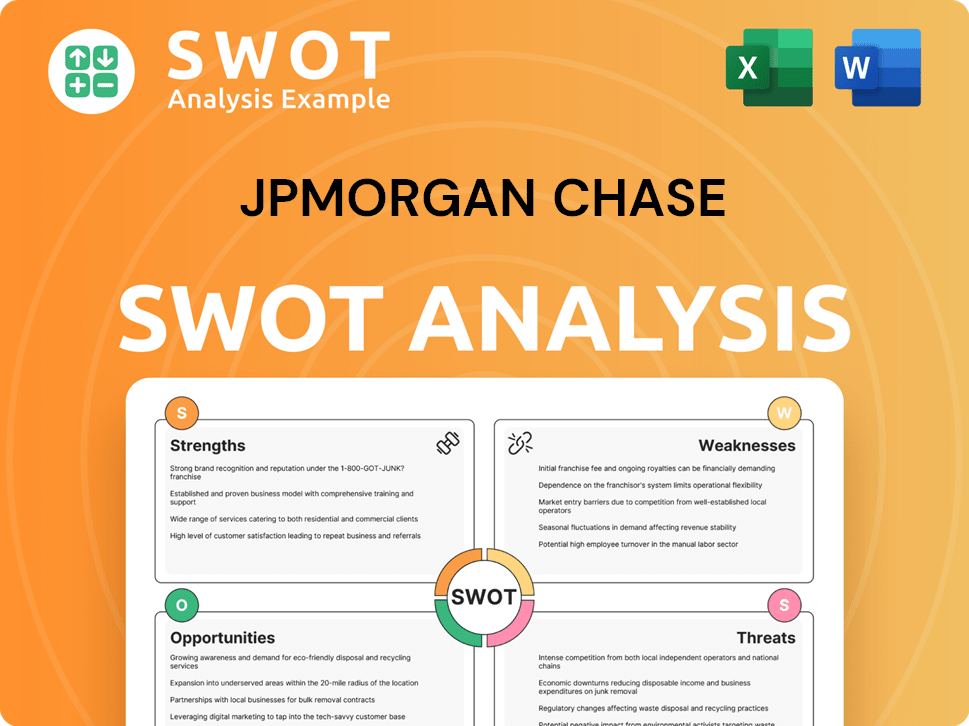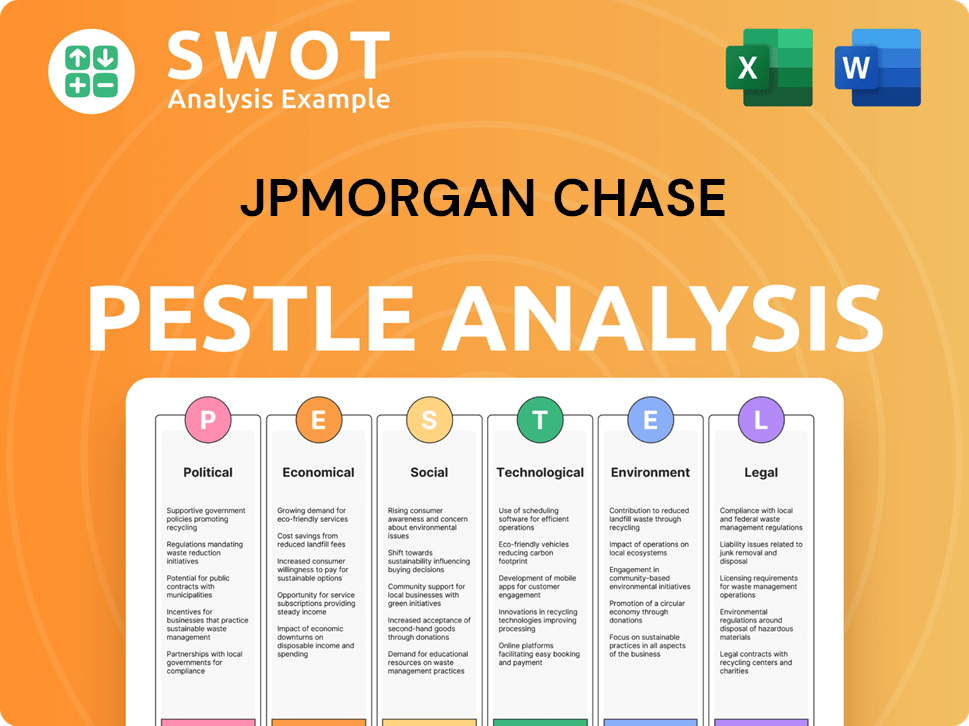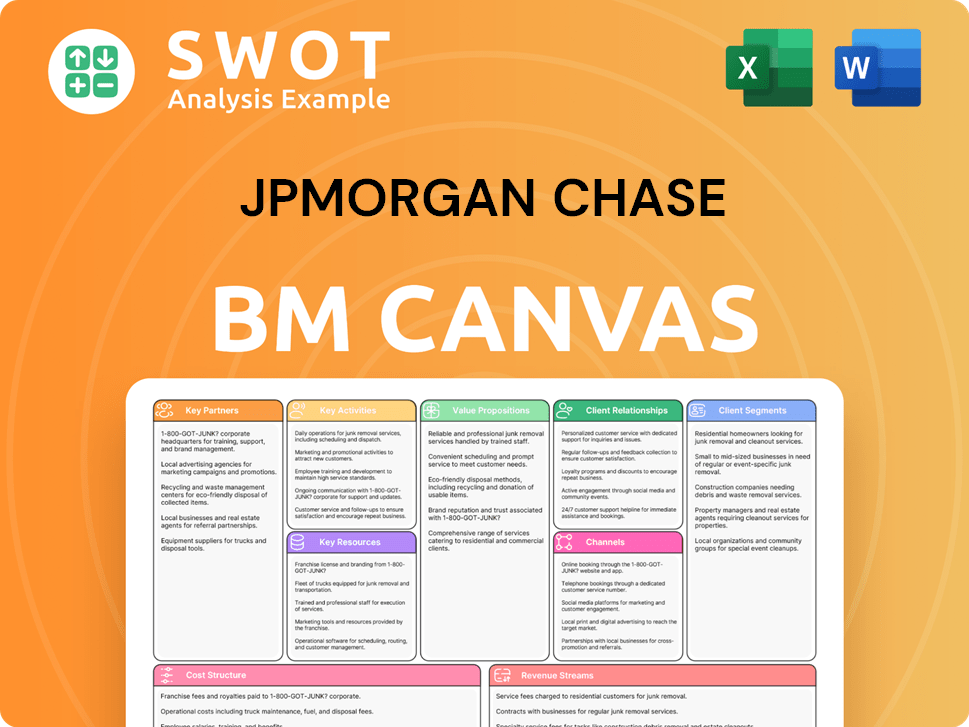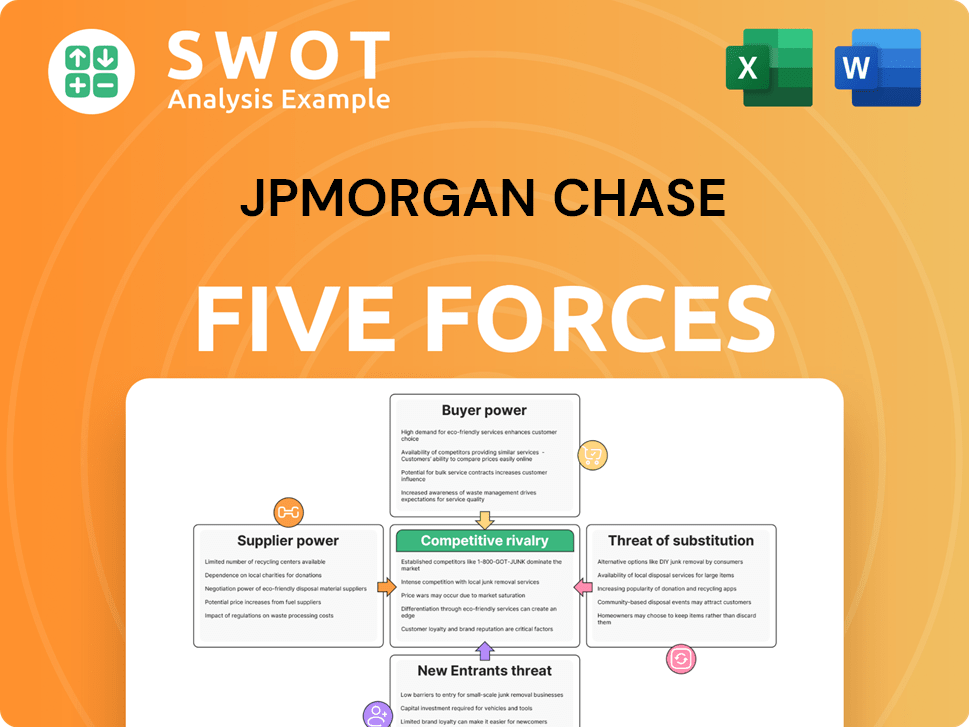JPMorgan Chase Bundle
Can JPMorgan Chase Maintain Its Dominance?
Founded in 2000, JPMorgan Chase & Co. has evolved from a merger into the world's largest bank by market capitalization, a testament to its robust growth strategy. With a staggering $4.0 trillion in assets, the firm's journey from its 1799 origins to its present-day status is a compelling narrative of strategic foresight and financial prowess. This exploration will dissect the JPMorgan Chase SWOT Analysis to understand its current position and future trajectory.

JPMorgan Chase's strategic acquisition of First Republic in 2023 exemplifies its proactive expansion strategy within the competitive financial services industry. Its future prospects hinge on navigating the complexities of the market, including technological advancements and economic fluctuations. A deep dive into JPMorgan Chase's strategic initiatives, including digital transformation and investment banking, will reveal the drivers behind its projected financial performance and long-term investment outlook.
How Is JPMorgan Chase Expanding Its Reach?
The JPMorgan Chase growth strategy involves a multifaceted approach to expand its market presence and diversify its service offerings. The company is actively investing in both physical and digital channels to reach a broader customer base. This strategy is designed to capitalize on emerging market opportunities and strengthen its position within the financial services industry.
A key component of JPMorgan Chase's future prospects is its commitment to strategic initiatives that drive revenue growth and enhance profitability. The firm's focus on digital transformation and sustainable finance further positions it for long-term success. The company is also focused on a strong JPMorgan Chase company culture, which is crucial for its expansion strategy.
The firm's expansion efforts are multifaceted, encompassing both physical and digital banking initiatives, as well as international growth strategies. As the competitive landscape evolves, the company is adapting to meet the changing needs of its customers and maintain a strong market share.
Following the acquisition of First Republic in May 2023, JPMorgan Chase has been converting former First Republic locations into J.P. Morgan Financial Centers. By May 2025, 14 new centers had been opened across key states. The firm plans to nearly double this number by the end of 2025, focusing on affluent client services.
The company is set to open over 500 new branches and renovate approximately 1,700 locations by the end of 2027. This expansion will create increased access to banking services across the U.S., with plans to hire 3,500 employees. For example, the firm plans to triple its branches in Alabama to 35 by 2030, adding over 170 bankers.
JPMorgan Chase launched its U.K. digital bank, Chase, in September 2021, accumulating 1 million customers and over £10 billion in deposits within a year. A digital bank is planned to launch in Germany in late 2024 or early 2025, with Berlin as its base for consumer operations in the EU.
Overseas digital efforts were expected to incur losses of around $450 million in 2022 and similar amounts for the next few years. The firm anticipates breaking even by 2027 or 2028 and generating significant income thereafter. The firm increased its direct lending commitment to $50 billion as of February 2025.
JPMorgan Chase is also enhancing access to supply chains for underserved U.K. small businesses through a £1.2 million program with Newable. This program connects 15,000 businesses to major vendors with government contracts, supporting their growth and resilience. These initiatives are part of a broader strategy to foster economic development and support small business.
- Expansion of physical branches and financial centers to increase market reach.
- Launch of digital banking platforms in new international markets.
- Investment in programs to support small businesses and supply chains.
- Focus on sustainable finance and digital transformation to drive long-term growth.
These expansion initiatives and strategic investments highlight JPMorgan Chase's commitment to sustained growth and its ability to adapt to the evolving financial landscape. For a broader understanding of the competitive environment, you can explore the Competitors Landscape of JPMorgan Chase.
JPMorgan Chase SWOT Analysis
- Complete SWOT Breakdown
- Fully Customizable
- Editable in Excel & Word
- Professional Formatting
- Investor-Ready Format

How Does JPMorgan Chase Invest in Innovation?
The innovation and technology strategy of JPMorgan Chase is a cornerstone of its sustained growth, significantly impacting its future prospects within the financial services industry. The company's commitment to technological advancements is evident in its substantial annual investments, which are strategically allocated to drive digital transformation and enhance customer experiences.
This approach is crucial for maintaining a competitive edge and adapting to the evolving demands of the market. By focusing on digital products, personalized services, and operational efficiencies, JPMorgan Chase aims to strengthen its market position and improve financial performance. A deeper understanding of the Target Market of JPMorgan Chase also helps to appreciate the importance of these technological advancements.
The firm's dedication to innovation is reflected in its substantial technology budget. In 2024, the company allocated $17 billion to technology, with a planned increase to $18 billion in 2025. These funds are primarily directed toward digital transformation initiatives, including the integration of artificial intelligence (AI) and machine learning to improve digital products and personalize customer experiences.
JPMorgan Chase has been investing in AI for over a decade, initially focusing on risk management, particularly fraud detection. The firm is expanding its AI use cases from 450 in 2023 to a target of 1,000 by 2025.
Launched in 2024, LLM Suite provides over 200,000 employees globally with access to leading GenAI capabilities. This tool has reportedly led to productivity gains of several hours per week for certain key users.
The Asset & Wealth Management division saw a 20% year-over-year increase in gross sales between 2023 and 2024. AI-powered systems like Gen AI and Coach AI automate research and anticipatory tasks, reducing the time advisors spend searching for data by up to 95%.
The bank aims to expand client rosters by 50% over the next three to five years, enabled by AI's ability to streamline workflows and enhance service delivery.
The firm is modernizing its infrastructure with a hybrid cloud approach. Approximately 65% of its applications run on public or private clouds, with a goal to reach 70% by the end of 2024. The company is also reducing its private cloud footprint from 32 data centers to about 20 highly automated ones.
J.P. Morgan Payments scored No. 1 positions in the 2024 Coalition Greenwich Digital Transformation Benchmarking Study for its digital banking platforms, J.P. Morgan Access and Chase Connect.
JPMorgan Chase's technology strategy encompasses several key initiatives aimed at enhancing operational efficiency, improving customer experience, and driving revenue growth. These include:
- AI and Machine Learning: Expanding AI applications across various functions, including risk management, client services, and trading analytics. The firm aims to increase its AI use cases from 450 in 2023 to 1,000 by 2025.
- Digital Transformation: Investing in digital platforms to improve customer experience and streamline processes. This includes an omnichannel marketing approach to integrate various digital platforms.
- Cloud Migration: Modernizing infrastructure by adopting a hybrid cloud approach, with a goal to have 70% of applications running on public or private clouds by the end of 2024.
- Generative AI: Launching tools like LLM Suite to enhance productivity and provide employees with advanced AI capabilities.
JPMorgan Chase PESTLE Analysis
- Covers All 6 PESTLE Categories
- No Research Needed – Save Hours of Work
- Built by Experts, Trusted by Consultants
- Instant Download, Ready to Use
- 100% Editable, Fully Customizable

What Is JPMorgan Chase’s Growth Forecast?
JPMorgan Chase has shown strong financial results, setting the stage for continued expansion. In 2024, the firm's total net revenue reached $177.6 billion, marking a 12% increase from the previous year. This growth was fueled by a 4% increase in Net Interest Income and a significant 23% rise in Noninterest Revenue, demonstrating the effectiveness of its diverse revenue streams. These results underscore the company's robust financial health and strategic positioning within the financial services industry.
The company's profitability metrics also reflect its strong performance. JPMorgan Chase achieved a record net income of $58.5 billion in 2024, with a return on equity of 18% and a return on tangible common equity of 22%. Looking at the first quarter of 2025, the firm reported a net income of $14.6 billion, or $5.07 per share, with revenue of $42.0 billion, up 4.8% from Q1 2024. The profit margin for Q1 2025 was 34%, an increase from 32% in Q1 2024, showcasing its ability to maintain and improve profitability.
The company's performance is further supported by a strong capital position. As of December 31, 2024, JPMorgan Chase had a CET1 capital ratio of 15.7% and a total capital ratio of 18.5%. This robust capital base provides a solid foundation for future investments and strategic initiatives, allowing the company to navigate economic uncertainties and capitalize on market opportunities. For more insights, consider exploring the Brief History of JPMorgan Chase.
Management anticipates net interest income for 2025 to be approximately $94.0 billion. Adjusted expenses are projected to be around $95.0 billion, reflecting strategic cost management. These projections indicate a focus on maintaining profitability and managing operational efficiency.
The firm anticipates a net charge-off rate in Card Services of approximately 3.60% for 2025. The net profit margin for the quarter ending March 31, 2025, was 20.69%. The average net profit margin for 2024 was 19.59%, indicating stable profitability.
In 2024, JPMorgan Chase repurchased over 91.7 million shares totaling $18.841 billion. The company declared cash dividends of $4.80 per share. A new $30 billion common share repurchase program became effective July 1, 2024, demonstrating its commitment to returning value to shareholders.
Analysts forecast a slight marginal decrease in EPS for fiscal 2025 to $18.08 from $18.21 in fiscal 2024. However, they anticipate a rebound and 7.9% year-over-year growth to $19.51 in fiscal 2026, indicating positive long-term prospects.
JPMorgan Chase Business Model Canvas
- Complete 9-Block Business Model Canvas
- Effortlessly Communicate Your Business Strategy
- Investor-Ready BMC Format
- 100% Editable and Customizable
- Clear and Structured Layout

What Risks Could Slow JPMorgan Chase’s Growth?
The JPMorgan Chase company, despite its ambitious JPMorgan Chase growth strategy, faces a complex web of potential risks and obstacles that could influence its JPMorgan Chase future prospects. These challenges span regulatory, market, geopolitical, and operational domains, each posing unique threats to the firm's financial performance and strategic objectives within the financial services industry.
The investment banking giant must navigate a highly regulated environment, where changes in laws and regulations can increase compliance costs and potentially create competitive disadvantages. In addition, market risks, geopolitical tensions, and operational vulnerabilities, such as cybersecurity threats, add further complexities to the landscape. The firm's ability to effectively manage these risks will be crucial for its continued success and expansion.
The firm's performance is significantly influenced by market dynamics, including interest rate fluctuations, credit spreads, and overall market volatility. Increased loan delinquencies due to economic stress pose a potential credit risk, which could lead to higher credit losses and affect earnings. The firm actively manages these risks through hedging strategies and stress testing. For more insights, explore the Revenue Streams & Business Model of JPMorgan Chase.
Changes in laws, rules, and regulations can significantly increase compliance costs. Regulatory investigations can lead to substantial penalties and operational restrictions. The firm must continually adapt to evolving regulatory landscapes across various jurisdictions.
Fluctuations in interest rates, credit spreads, and market volatility can impact investment and market-making positions. An increase in loan delinquencies due to economic stress poses a potential credit risk. The firm uses hedging strategies to manage these risks.
Geopolitical tensions and political developments introduce economic uncertainty and instability. Potential policy changes, such as tariffs, can affect global expansion. Political instability or trade wars could negatively impact international earnings. JPMorgan Chase launched a Center for Geopolitics in May 2025.
Dependence on complex operational systems and third-party service providers poses risks. Cyberattacks and data breaches can harm reputation and lead to lawsuits. The firm invests in technology to improve operational resilience and cybersecurity measures. Inflation remains a key concern for businesses.
An economic downturn could significantly affect JPMorgan Chase's financial performance. Reduced consumer spending and business investment can lead to lower revenues. Increased credit losses from defaults on loans can also negatively impact profitability. The firm has to prepare for potential impacts.
Intense competition from other financial institutions can squeeze profit margins. The rise of fintech companies and digital banking platforms adds to competitive pressures. The firm must continually innovate and adapt to maintain its market share. In 2024, the company's net revenue was approximately $162.5 billion.
The firm's risk management organization provides independent oversight to foster a culture of risk awareness. They actively manage market and credit risks through hedging and stress testing. JPMorgan Chase is investing in technology to improve operational resilience and cybersecurity. The company's strategic initiatives also involve proactive measures to address and mitigate geopolitical risks.
Inflation remains a top concern for businesses, particularly small and midsize enterprises. Rising costs can squeeze profit margins and affect consumer spending. The firm is focusing on adapting its strategies to manage the impact of inflation. Management focuses on enhancing its risk management framework and compliance processes.
JPMorgan Chase Porter's Five Forces Analysis
- Covers All 5 Competitive Forces in Detail
- Structured for Consultants, Students, and Founders
- 100% Editable in Microsoft Word & Excel
- Instant Digital Download – Use Immediately
- Compatible with Mac & PC – Fully Unlocked

Related Blogs
- What are Mission Vision & Core Values of JPMorgan Chase Company?
- What is Competitive Landscape of JPMorgan Chase Company?
- How Does JPMorgan Chase Company Work?
- What is Sales and Marketing Strategy of JPMorgan Chase Company?
- What is Brief History of JPMorgan Chase Company?
- Who Owns JPMorgan Chase Company?
- What is Customer Demographics and Target Market of JPMorgan Chase Company?
Disclaimer
All information, articles, and product details provided on this website are for general informational and educational purposes only. We do not claim any ownership over, nor do we intend to infringe upon, any trademarks, copyrights, logos, brand names, or other intellectual property mentioned or depicted on this site. Such intellectual property remains the property of its respective owners, and any references here are made solely for identification or informational purposes, without implying any affiliation, endorsement, or partnership.
We make no representations or warranties, express or implied, regarding the accuracy, completeness, or suitability of any content or products presented. Nothing on this website should be construed as legal, tax, investment, financial, medical, or other professional advice. In addition, no part of this site—including articles or product references—constitutes a solicitation, recommendation, endorsement, advertisement, or offer to buy or sell any securities, franchises, or other financial instruments, particularly in jurisdictions where such activity would be unlawful.
All content is of a general nature and may not address the specific circumstances of any individual or entity. It is not a substitute for professional advice or services. Any actions you take based on the information provided here are strictly at your own risk. You accept full responsibility for any decisions or outcomes arising from your use of this website and agree to release us from any liability in connection with your use of, or reliance upon, the content or products found herein.